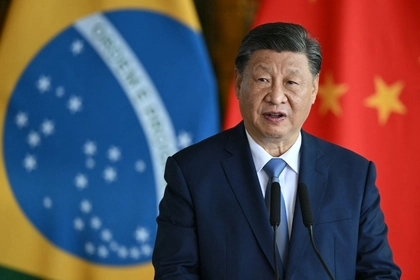Ukrainians increasingly hear proposals from international media outlets and observers that suggest Ukraine should abandon attempts to reclaim territories seized by Russia in 2014 or since the 2022 full-scale invasion. Even US President-elect Donald Donald Trump hinted at such a solution, stating, “It is very nice to talk about the return of territories, but most of the cities there are almost destroyed,” per Politico.
Aside from the norms of international law that directly recognize Russia’s war against Ukraine as illegal, Ukrainians consider they have an inalienable right to their territory do all other countries whose permanent borders were established since the Second World War – borders that Russia itself recognized in 1991.
Beyond this, the plight of millions of people living in the occupied territories underscores Russia’s attempts to suppress and harass the indigenous population, stripping them of property and reducing them to second-class status compared to Russian citizens brought into these areas.
Kyiv Post spoke with experts, human rights defenders monitoring the occupied territories, and residents from those areas. Many accounts are anonymous to protect vulnerable sources from potential imprisonment, physical harm, or loss of property on charges of “espionage” due to speaking with the media.
Destruction and oblivion
Currently, more than one million Ukrainians remain in Russian-occupied territories, with some sources suggesting this number could be as high as 1.5 million. Iryna Vereshchuk, former Minister for Temporarily Occupied Territories, cited a figure of 1.2 million people at the end of 2022.

Russian Troops Store Ammo in Civilian Homes in Occupied Zaporizhzhia
Most territories occupied after 2022 were severely affected by fighting, particularly from Russian artillery and airstrikes, which indiscriminately destroyed residential areas and infrastructure. Cities such as Volnovakha, Marinka, Vuhledar, Popasna, Kurakhove, Bakhmut, Soledar, Mariupol, and Severodonetsk were nearly obliterated. Mariupol, once home to 500,000 people, saw over 20,000 killed by relentless Russian bombing, according to the city council.
Russian installed authorities have admitted that they would not even attempt to rebuild some cities, such as Volnovakha. After the capture of Vuhledar, a mining town with a population of 11,000, only about 100 residents remained. Its infrastructure was so extensively damaged that repairs were deemed impossible.
In liberated areas such as Izium in the Kharkiv region, restoration of homes and utilities has been ongoing for two years, with significant work still needed. Ukraine actively rebuilds its liberated territories, conducts demining operations, and restores critical infrastructure, as evidenced in regions like Chernihiv, Kyiv, and the south.
In contrast, the Russian occupation administrations have not restored any infrastructure, even in areas seized at the outset of the full-scale invasion in February 2022.
“Our village has been adjacent to the demarcation line since 2014 but remained under Ukrainian control until the start of the ‘Great War’,” says Andrii, a pensioner from an occupied village in the Luhansk region. “We still have no electricity. Heating has been restored in two-story houses, but the coal mines no longer operate, forcing us to buy coal from Russia at higher prices. Our store hasn’t reopened, and mobile communications are almost nonexistent.”
Andrii contacts relatives in Kyiv weekly using the limited availability of cell phone connections. He refuses to leave his home despite the grim conditions.
“Time seems to have stopped. Nothing is being restored to the level it was before. The territories are not even cleared of mines. When we asked the occupation administration for help, they told us, ‘Go and clear the mines yourself’,” Andrii says.
Reports from Russian propagandists inadvertently confirm the lack of restoration efforts even as they attempt to justify the occupation, they are forced to show the destroyed Ukrainian cities and villages and acknowledge that the Russian authorities are not doing anything to improve the situation.
Even in major cities like Severodonetsk, which once had a population of 120,000, essential services such as heating, internet and mobile networks remain unavailable. However, the occupation administration proudly showcased telephone booths installed around the city, equipped with landline phones.
“You need permission for everything, just like in Soviet times. The paper bureaucracy is back. To rent out housing, you must go to the former cinema, which miraculously survived, stand in line, and get a ticket allowing you to rent out housing for a set number of days. The same applies to mobile connections or the internet. If you don’t follow the rules, you can be arrested, or your housing may be confiscated,” says Anna, a resident of Severodonetsk.
This is not surprising, given that Russia fails to improve conditions even in Russian territories adjacent to the occupied Ukrainian regions.
Confiscation and ethnocide
One of the reasons many local residents remain in the occupied territory and endure life under the occupation authorities in dilapidated cities is the confiscation of housing. If a person is absent for a long time, their housing is seized and then either resold or “distributed” to Russian military personnel.
“Special funds have been created in the occupied territories as part of the occupation authorities, tasked with the systematic alienation of property. In other words, this is a systematic process controlled by the Russian authorities. Initially, housing was confiscated from those who refused to accept Russian passports in the occupied territories, but now it affects everyone.
“Over the past three years, 856,499 apartments or houses have been confiscated from owners in the Zaporizhzhia, Kherson, Donetsk, and Luhansk regions. In addition, commercial real estate, including office spaces, has also been seized.
“For example, in Luhansk, more than 80% of office real estate has been confiscated, even though many of the original owners supported Russia’s seizure of Luhansk in 2014. This is how Russia repaid them for their loyalty and betrayal of Ukraine,” says Pavlo Lysyansky. He is the former representative of the Ombudsman of Ukraine in the Donbas, adviser to the Ombudsman on Donbas issues in 2022, director of the Institute for Strategic Studies and Security, and Doctor of Philosophy in Political Science. He prepared a detailed analytical report on the volume of confiscated property.

In addition to apartments, hundreds of industrial enterprises, about 1,500 mines, and even 3.4 million hectares of agricultural land have been confiscated. According to one of the authors of the study, analyst and journalist Maxim Butchenko, the Russian authorities create artificial obstacles for those who wish to return to the occupied territories, even on Russian terms, to confirm their ownership.
“The system is designed so that even those who wish to return cannot do so to confirm their ‘rights’ to their property under Russian law. Meanwhile, Russia actively settles the occupied territories with its own people, forcibly changing the make-up of the population,’ Butchenko explains.
According to Lysyansky, apartments confiscated from Ukrainian citizens are issued to Russian citizens from within the Russian Federation at very low mortgage rates - 2% (while mortgage rates in Russia are typically 27–30%).
This policy aims to replace the Ukrainian population with Russians. The process is so widespread that reports occasionally surface in Russian media or on social networks. Recently, many residents of Mariupol protested against the demolition of their homes, which had been damaged during Russian attacks. According to locals, the occupation administration is hastily constructing new buildings in place of the demolished ones and renting or selling the new apartments to Russians who can afford them not to the original residents who, facing significant infrastructure and employment challenges, cannot afford such housing.
“They [Russians] don’t want loyal locals; they want their people. Russia’s tactics remain unchanged: invade through military means, oust the locals, and repopulate with their citizens. This war is aimed at annihilation,” Viktor Kononenko, Lieutenant General of the SBU and former head of the Defense Department of National Statehood says.
Russia’s harsh discriminatory and filtering measures, previously reported by Kyiv Post, are designed to prevent residents of the occupied territories who have become refugees from returning home. These measures directly contribute to the devastation of the occupied territories.
“For instance, in 2024, according to our data, only 21,272 people visited all the occupied territories of Ukraine - and almost all of them returned to Ukrainian-controlled territory. This is about ten times fewer than in 2022,” Lysyansky said.
Stopping the violence
Russia’s strategy of neglecting the restoration of occupied territories while gradually absorbing them, displacing Ukrainians, and replacing the once-large Ukrainian population with a smaller but militarized Russian one – including a substantial proportion of special services personnel, military members, and their families – bears all the signs of ethnocide: A violent alteration of the population’s ethnonational composition.
This process occurs alongside the militarization of these territories, which will not only prevent de-escalation in the foreseeable future – even in the event of a “truce” – but also prepares the aggressor for a new stage of hostilities, leveraging the transport infrastructure and geographical advantages of the occupied territories. These areas could become what Crimea and occupied Donetsk were for Russia in the spring of 2022: springboards for new offensives.
These negative processes can be stopped not only by rejecting Russia’s claims to these territories but also through decisive actions to return the territories to Ukraine. Otherwise, these occupied, militarized lands with uncertain legal status will pose a significant challenge to European security for many years to come.
You can also highlight the text and press Ctrl + Enter










